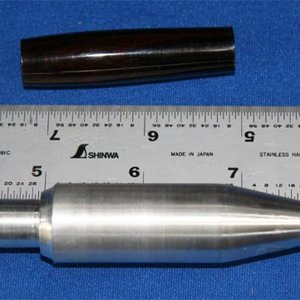jbg230
Member
I haven't seen anything real specific about this, but as I have started to pay attention to more detail, I'm wondering what those with more experience do regarding the build up of CA at turned portion of the nib and cap ends of the blank during the finishing process.
I'm wondering how thick a layer of thin CA is and how thick a layer of medium CA is. That would certainly help, but I'm sure that's an unfair question since there's so many variables. So my bottom line question is if it's common to turn a little bit further past the bushings, to compensate for the extra thickness of the final CA layers. And if so, how much further past the bushings?
I use a small piece of 400 grit sandpaper on a flat section of the lathe to sand down the build up of extra CA at the open ends of the finished blanks, but it's the build up of CA on the turned nib and cap ends that is the frustration. Just when you think I'm done, I find I have to put the blank back on the mandrel and turn down the ends with a tiny piece of 600 grit and re-polish. I'm not sure if it'd be worse trying to compensate by "over turning" those ends and "build up" to the bushing with the CA.
I'm wondering how thick a layer of thin CA is and how thick a layer of medium CA is. That would certainly help, but I'm sure that's an unfair question since there's so many variables. So my bottom line question is if it's common to turn a little bit further past the bushings, to compensate for the extra thickness of the final CA layers. And if so, how much further past the bushings?
I use a small piece of 400 grit sandpaper on a flat section of the lathe to sand down the build up of extra CA at the open ends of the finished blanks, but it's the build up of CA on the turned nib and cap ends that is the frustration. Just when you think I'm done, I find I have to put the blank back on the mandrel and turn down the ends with a tiny piece of 600 grit and re-polish. I'm not sure if it'd be worse trying to compensate by "over turning" those ends and "build up" to the bushing with the CA.

